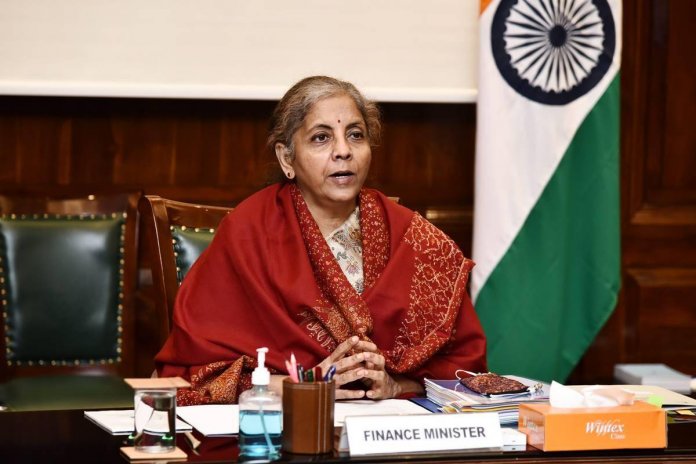
The Covid-hit economic environment is a nightmare for any Finance Minister to present a budget. Of course, this is one of the worst periods in post-independence economic history. The pandemic necessitated immediate fund transfer to the people and supply of food items. On the other side, it produced the deepest economic crisis in the form a 7.7% GDP contraction. You have to save the people and the economy simultaneously at the same time, both were not in a state to support the exchequer.
Covid pandemic created lockdown crushed revenues. Borrowing became the chief resource mobilisation tool. Expenditure commitment can’t be reduced as the wounded economy and suffered people need government care. Still, the budget 2021-22 set an example for beautiful budget crafting.
Look at the balance sheet of the government that is expressed as receipts and expenditure. For the current year (2020-21 RE), total tax revenues of the government were around 9.8% of the GDP and government borrowed 9.5% of the GDP to finance the budget. Borrowing was almost equal to the tax revenue available for the government to run the budget.
Governments total borrowing was Rs 9.3 lakh crore during 2019-20 (actual), but it was compelled to borrowing Rs 18.4 lakh crore during the next year (2020-21 RE) as Covid put the economy into ventilator. No further data is needed to show how short is the government in the revenue side.
For an apt analysis of the budget, we should look into the Revised Estimates (RE) for the current yea (2020-21). This is because the budget of the next financial year (2021-22) has its foundation in the Covid hit financial year and budget interventions of the current year.
More than that Budget Estimates are gone fantasies whereas Revised Estimates are the current realities. When you try to analyse budget 2021-22, let your study start from the 2020-21 situation (RE).
Hence, look at the Revised Estimates for the current year ie.2020-21, there we can see the extend and impact of the Covid Pandemic on government finances.
| Item | 2020-21 (BE) | 2020-21 (RE) | Difference (Rs Crores) | Difference in % |
| Net Tax Revenue | 1635909 | 1344501 | -291408 | -17.8% |
| Non-tax revenue | 385017 | 210652 | -174365 | -45.28 |
| Disinvestment | 210000 | 32000 | -178000 | -84.2 % |
| Total Expenditure | 3042230 | 3450305 | -408075 | +13.4% |
| Borrowings or FD | 796337 | 1848685 | 1052318 | +132% |
If you don’t have the patience to go through the boring figures, understand their implications at least. Compared to the budget estimates, government’s net tax revenue which is the main source (around 65%) to finance its expenditure was short by 17.8%, non-tax revenue including profits of PSEs was lower by 45% whereas the disinvestment proceeds were short by 84%. All these resulted in a revenue shortage of Rs 6.5 lakh crores. All of these revenue shortages were significantly affected by the Covid induces lockdown.
Come to the other side, total expenditure has been increased by 13% during 2020-21. What all items caused this sudden expenditure hike?
Understandably, the Covid compelled the government to make some urgent expenditure. Provision of free food to millions of people one such intervention.
Here looking at the expenditure items that caused stark deviation from the estimated budget is to be understood.
Food subsidy was estimated to be just 1.15 lakh crore during 2020-21 BE, but it ultimately went up to a staggering Rs 4.2 lakh crores or an increase of 265%. Remember the normal food subsidy amount is around Rs 1.2 lakh crore for the past so many ears. Here, those who are criticising the government for reducing the food subsidies from Rs 4.2 lakh crore to Rs 2.42 lakh crore are conveniently forgets the normal food subsidy situation. Efforts for the reduction of the food subsidy in the new budget is a commendable economic step that has been made with political courage.
Another major increase was made in rural employment programme of NREGS, up from Rs 61.5 k crores (BE) to Rs 111 k crore (RE). Providing income to the people during the covid pandemic was essential to support poor families. But a reduction of the high allocation from the 2020-21 (RE) levels made in the 2021-22 budget for the NREGS is a logical step.
Shift from immediate income support to productive economic stimulant
While examining the items of the expenditure during the current year, we can see that seven of the nine expenditure heads that registered the largest increase are related to Covid rehabilitation. This includes, food subsidy, fertiliser subsidy, rural employment, social security and welfare, civil supplies, medical and health expenditure.
Here, the 2020-21 budget expenditure was dominated by immediate support measures like food subsidy, income transfer, rural employment etc. Coming to the new budget (2021-22), the expenditure item is dominated by health care to escape from the Covid like Vaccination, PM Atmanirbhar Swasthya Yojana etc.
Capital expenditure enhancement became a realty
In the past, several Finance Ministers made luxurious talk about enhancing the productive capital expenditure. But none was able to achieve the goal because of higher revenue expenditure commitments.
The 2021-22 budget here is a departure. Capital expenditure has been increased by 26%. Focus on infrastructure is clearly visible even with direct government spending on projects like industrial corridors at a time when the government is facing severe revenue shortages.
FM was able to make a smart shift in expenditure strategy away from immediate income and food support to health facilities (vaccination and PM Atmanirbhar Swasthya Yojana) and economy stimulation is clearly visible and that is one attractive element of this budget.
Ms Nirmala Sitharaman highlighted that the theme of her budget is spent, spent and spent. Here also her budget brings a fresh direction. For the first time in the last two decades, a significant increase in capital expenditure has been made (26%).
Unexpected pleasantries
The new budget brings some unexpected, pleasant measures. One such intervention is the proposal for the creation of a duo – an Asset Reconstruction Company and an Asset Management Company for addressing the NPA problem. For a long time, the economy was waiting for such a step but because of one or another reason, action on this front missed.
Another pleasantry is the creation of a dedicated Development Financial Institution (DFI) for providing loans to the infrastructure sector. Value of such a DFI is that it will reduce the burden of commercial banks. The current NPA problem is partly caused by bank loans to the long term and risky infrastructure sector. Still, creation of both the ARC-AMC for NPAs and the DFI for infrastructure loans need more policy actions.
At the same time, the method of privatisation for PSBs, rather than going for Bank Investment Company is a hard selection.
Overall, the Finance Minister has set aside the FRBM bindings with ease. There is no talk of the 3% Fiscal Deficit target, there is no escape clause. At the same time, when we compare the 2021-22 (BE) total expenditure with the 2020-21 BE figures, total expenditure has been increased just by 1%. This shows that the FM kept the desirable output of fiscal discipline while crafting the budget.
*********











